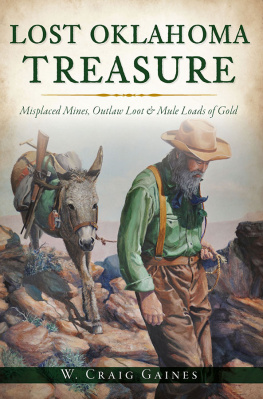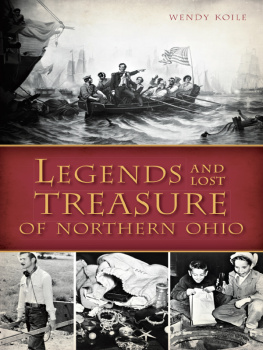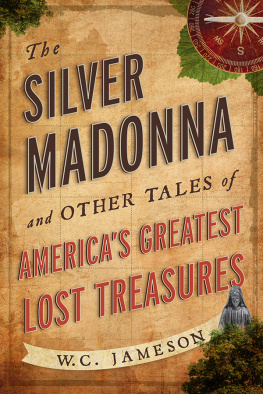

Published by The History Press
Charleston, SC
www.historypress.com
Copyright 2021 by W. Craig Gaines
All rights reserved
Front cover: W. Craig Gaines.
First published 2021
e-book edition 2021
ISBN 978.1.43967.219.8
Library of Congress Control Number: 2020948633
print edition ISBN 978.1.46714.789.7
Notice: The information in this book is offered without guarantee on the part of the author or The History Press. The author and The History Press disclaim all liability in connection with the use of this book.
All rights reserved. No part of this book may be reproduced or transmitted in any form whatsoever without prior written permission from the publisher except in the case of brief quotations embodied in critical articles and reviews.
CONTENTS
INTRODUCTION
OKLAHOMA TREASURE
Ever since I was a young boy, I have been interested in history and lost treasure. Growing up in Oklahoma, I was fascinated by its diverse history and tales of lost treasure. Oklahoma was part of Native American, Spanish, French, Mexican, Texan and American lands.
I got my first metal detector when I was in junior high school and spent a lot of time digging up metal objects in my yard, other yards, school grounds and eventually the great outdoors of Oklahoma. Over the years, I traveled to all parts of Oklahoma on adventures of discovery, sightseeing and learning. In those years, Ive researched and accumulated many tales and much historical information from a wide variety of sources.
The basis of these mostly legends were folk stories passed on by word of mouth from generation to generation. They usually have a basis of truth or at least someones understanding of the truth. The early stories of lost gold and silver mines and the hiding of Spanish wealth are based mostly on stories developed by early settlers from the legacy of Hernn Cortss conquest of Mexico. Evidence that Spanish explorers had been in Oklahoma came from Spanish arms and gear often found by ranchers and farmers.
Many stories came from newspaper accounts over the years. Some accounts are fiction conjured up by a writer for reader amusement, but others are factual. In the 1930s during the Great Depression, the Oklahoma Historical Society and larger Oklahoma newspapers gathered interviews with Civil War survivors and Oklahoma settlers. At that time, lost treasure stories were popular, and many Civil War and postCivil War lost treasure stories were first put into print then. J. Frank Dobies Coronados Children was a collection of lost mines and lost treasure in the Southwest, including Oklahoma, that became a popular book.
Almost every family seems to have a lost treasure story associated with it. Sometimes a family member died without telling where he or she hid the family fortune or their egg money. Often a farmer plowing a field would mysteriously find scattered coins uncovered by the plow from some forgotten cache, such as my friends family did.
Cherokees and a number of Native Americans learned about gold mining in Georgia during the great gold discoveries there that resulted in the United States taking their lands and removing them to Indian Territory in distant Oklahoma. When gold was discovered in California in 1848, the migration of would-be miners from the East through the Indian Nations on what became known as the California Road caused much excitement among the Cherokees. An internal destructive civil war between members of the Cherokees and other tribes over treaties signed by some tribal members with the United States caused some migration of tribal members to California to escape death threats and maybe to find gold. A few Cherokees were successful in finding gold in California and returned to the Indian Nations with it. Some of this gold still lies buried in Oklahoma. Successful miners returning east sometimes hid their gold during Indian and outlaw attacks.
The Civil War in Oklahoma devastated Indian tribes and nations who had established farms, ranches, schools, churches, mills and towns. A large number of people died during the war. About 28 percent of the Indians who served in the Union military died during the Civil War. Some left behind money that was never found. These Civil War treasure stories are true stories for the most part.
After the Civil War, many ex-soldiers did not adjust well to civilian life as farmers and cowboys. Some became outlaws who used the Indian Nations as a haven to hide out. Jesse James, Frank James and their relatives the Youngers formed the James Gang, which robbed banks, trains and citizens throughout the Midwest and left a lot of tales of buried treasure. The Knights of the Golden Circle were said to have been involved in some of these activities among die-hard ex-Confederates.
After the Civil War, the Indian Nations were reorganized as the United States took lands from the Five Civilized Tribes and gave it to other tribes or kept some lands as unassigned. Later, part of western Oklahoma became Oklahoma Territory and eastern Oklahoma became Indian Territory. Settlers were given homesteads and land rights on what had been Indian land. Railroads were constructed through these lands. Outlaw gangs on horseback carried out a number of robberies. The Dalton Gang, Doolin-Dalton Gang and others made their mark on Oklahoma. It is likely some outlaws left behind caches of loot before they met violent deaths. A number of small caches have been found in recent years. Many finds were based on so-called Jesse James maps that people acquired copies of.
One of my interests has been shipwrecks. There are still a few old shipwrecks in the Arkansas River and Red River in Oklahoma.
Much of this material came from my research for my books and articles. I have organized the treasure stories by county for ease of discussion and so the reader can locate treasure stories by geographic location. Some stories cover several counties, so I have put the story in one county and referenced it in the other county where it may be located. For most of these stories, I have tried to briefly tell the tale based on multiple sources. Steve Wilsons Oklahoma Treasure and Treasure Tales is one of the best sources for information on a number of these treasures. I have done my best to sort through the many versions of these treasure tales and give my opinion of them. The treasure values given in these stories are what legends have stated, but few lost treasures are actually worth millions of dollars.
I hope you get to visit the areas where these treasure tales take place. Enjoy the people and places in your travels like I have done. You might even find new treasure stories that I dont have in this book. With a bit of luck, you could become a treasure finder instead of a treasure hunter.
W. Craig Gaines
Tulsa, Oklahoma
2020
CHAPTER 1
TREASURES BY COUNTY
ADAIR COUNTY
Farm Cache
A farmer hid his familys money on his farm near the Illinois River not far from Chewey. He died without telling anyone where it was. When I was young, I searched for it briefly with my first metal detector with the help of a friend whose family was from the area. The old homestead was long gone, and the directions were a bit vague about where the house originally was.
ATOKA COUNTY
Bill Cooks Lost Loot
See .
John C. White Treasure
In the 1920s, rancher John White was rumored to have buried a quart jar full of five-, ten- and twenty-dollar gold coins close to his ranch house near Harmony, east of Atoka. He told W.F. McKown about burying the gold in 1923. White was leasing the ranch from others. White got sick and died in Texas. In 1960, some of John Whites relatives came to the area and looked for their uncle Johns money but did not appear to have found it.
Next page







